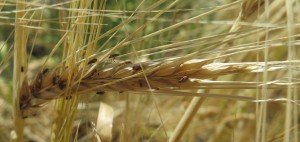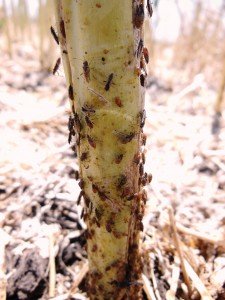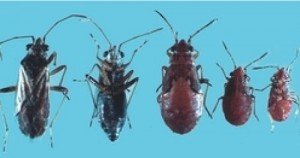Rutherglen bug (RGB) numbers in canola stubble are again high in some fields. These infestations pose a risk to neighbouring crops, either through damage to establishing summer crops or contamination of unharvested winter crops. Both the canola and adjacent crops warrant monitoring for RGB infestation and movement out of the canola field. If large number of nymphs move into adjacent fields with seedling summer crops (cotton, mungbean, soybean, sorghum, maize) they can cause the seedlings to dehydrate and die from sheer feeding pressure (see video of RGB impact on a cotton seedling over a 4 day period).
In the event of high RGB numbers, seed treatments will not protect the seedlings from feeding damage, and plants on the field margins may be killed. Before RGB will die from feeding on a seed treated seedling they have to feed, and the cumulative feeding damage of dozens of RGB can kill the seedlings.
RGB may also pose a contamination risk to neighbouring winter cereal crop at harvest. RGB have been observed congregating in the heads of a barley crop adjacent to canola. The first 50m of the barley was infested with RGB numbers dropping off further into the crop. Where crops are infested with RGB at harvest, segregation of the grain from the infested area may be warranted to avoid high levels of live insects in the load.
RGB may start moving out of canola crops prior to harvest, so monitoring susceptible summer crops adjacent to both harvested and standing or windrowed canola is suggested.
Movement of RGB into budding sunflowers can also increase the risk of damage along the field edge closest to the canola.
If infestations have a clear edge effect, there is an opportunity to control the RGB in the affected portion of the field only, rather than the whole field. RGB movement out of canola can occur over several weeks, so ongoing monitoring and repeated treatment of problem areas may be required.
Watch a short video that shows the density of RGB nymphs moving out of the canola stubble.
Rutherglen bug biology
Rutherglen adults move into canola during flowering – podding. Females lay eggs up to 400 eggs each into the soil, trash and around the base of the plant. The eggs are elongate, about 2mm in length. Eggs are white when laid, reddening as the nymph develops inside. First instar nymphs hatch in 5-10 days (shorter when warmer temperatures). Over 3-4 weeks, the nymph moults 3-4 times before moulting to adult. Nymphs are distinguished from adults by the absence of wings. Later instar nymphs have visible wingbuds.



